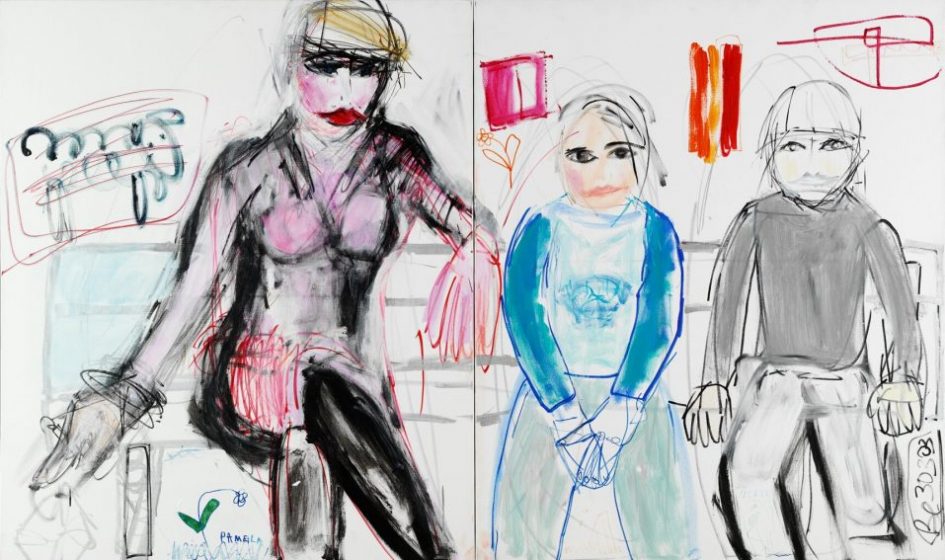“The Meeting Bench”
Text by Bogusław Deptuła
Once her guests had settled in – which came easily because their host is both open and direct – the painter would go to work. These portraits do not focus on external similarity – a skillful painter has little problem achieving that. Beata was after something else, namely, images that would capture the personality of the individuals who found themselves opposite her, painterly equivalents of each subject’s uniqueness, singularity. She also strove to describe one other thing: the aura of each of us. As she herself said when speaking about her adventure (for that was how she termed the creation of this series), the place where she met with her models remained unchanged – it was always her studio. With the entry of each individual or couple, the space would become completely different. Her guests would change it through their behavior, personality, clothing, and voices. The interior effectively underwent a series of transformations. Are they visible in the portraits? I think they are. The energy, colors, and expression of her canvasses change markedly, in spite of the painter remaining faithful throughout to a given technique and a single aesthetic.
Her technique is intriguing. It draws much from poster design and drawing. For a graduate in graphic design, a visual style that relies on the line for its artistry seems completely natural, almost unavoidable. There are many lines – black, colored, some accidental – yet ultimately all are necessary. One can tell that someone with character created them. Paintings may be corrected, finished over time, but at the first, personal meeting between artist and model, there must be a spark – some that connects, otherwise nothing will come of it. Sparks seem to have been flying. The paintings glow abundantly. In spite of possessing a unified style, they are strongly individualized based on human difference – something the painter was intent on capturing.
When she began working on “Meetings,” a series that aims to underline the uniqueness and intensity of each subject, Beata was not aware of what she would achieve. The result, however, has turned out to be one of the few broadly conceived, collective portraits in Polish contemporary art. It is not a “Poles’ portrait of themselves,” but rather a group portrait of young Varsovians – but already that is very much. Somewhere in these paintings is a record of perhaps not an entire community, but a certain group of people who – we should assume – have much in common. Similar in age, they frequent similar places and are interested in similar things. This is the portrait of a community. Accompanied by a recording of the conversations that transpired during these portrait sessions, it would provide us with information about the state of mind of the participants, all inhabitants of this city. This is worth underlining: these are portraits of Varsovians, people essential to this city.
Composed of two framed canvasses, arranged either horizontally or vertically, these paintings are significant in size and highly expressive. They are being shown in an interior (formerly a bank) that has been vacant for years. The original paintings will hang inside, while a large, seventy-square-meter screen on the building’s façade will be used to show them to those Varsovians who find neither the time nor the energy to enter. This is a novel way of displaying art in the capital, a new way of allowing accidental viewers, passers-by, a glimpse of the art being created today.
Most will probably be unaware that Beata Konarska has been a regular presence in their homes for some time. Few know this, but Beata’s most disseminated work are the visuals she produced for channel 2 of Polish State Television. Her inserts and program transitions, titled “Inspired by Art,” have sought for three years to expose television viewers to works by a number of great artists. Beata’s animations were inspired by Dali, Warhol, Matisse, Klee, Magritte, Chagall, Calder, and Toulouse-Lautrec. Another work was the animated title sequence for reports on the Picasso exhibition held at the National Museum in Warsaw. I watched these films full of admiration for their author, who I did not know at the time. It turned out to be Beata Konarska.
“Meetings” will give Varsovians a chance to look upon their own image in the mirror of art, see how Beata has chosen to depict some of them. Beata Konarska’s images on the façade of a beautiful building might just prove a very special event in Warsaw, one that might breathe new life into the capital’s somewhat listless art scene. It is worth seeing precisely because these were “Meetings.”






























